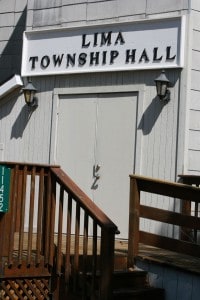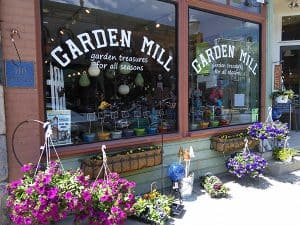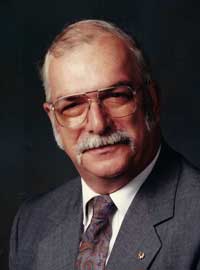
By Jim Pruitt
The fate of the Lima Township Hall is still up in the air after a special meeting of the Board of Trustees collected comments from residents.
The Dec. 2 meeting was convened to give the ad hoc committee (assigned to come up with a recommendation to the board) a chance to present its findings and to answer questions.
The committee will meet again next month to discuss a new option and will bring the public in for another forum in March.
The hall dates back to the 1830s and has been home to two congregations, a private outfit and a grange hall over the years and still holds a prominent spot in the old Lima Village. There are stained glass windows covered up at the front of the building.
The growth of the township has some folks thinking a new hall is needed to adequately house elections and to offer upgraded facilities and handicap access. The basement is unusable and the bathrooms are not far behind.
The ad hoc committee was formed two years ago to study what could be done with the structure. After researching the issue they commissioned a survey asking for resident comments.
The survey was sent out with the recent tax bills asking residents what they thought and the responses came in favor of building new by 2-1 margin, Committee Chair Ed Greenleaf said. However, sentiment among the audience of 25 people was decidedly in favor of preserving the hall.
Whatever option the township chooses, the facility will need to be energy efficient and have an updated well and septic system, Greenleaf said.
Committee member Bill Coultre said the existing hall has its strengths and weaknesses. The basement is Michigan Stone with a lime and sand mortar that if tuckpointed could stand for a long time. The structure is solid and has a new roof.
The weaknesses include sitting 3 ½ feet above the ground at the front and 5 feet high in the back. That makes its hard to meet Federal rules for handicap access, Coultre said.
The hall needs updated wiring (last done in the 1970s) and new heating and cooling (there is no air conditioning now).
The floor of the 1,500 square foot building needs to be reinforced, but with only one exit in front and one in the back, the maximum capacity is 75 people, Supervisor Craig Maier said.
Maier favors constructing a new hall that can be built at grade level and offer proper handicap access. Refurbishing the existing hall would require an 80-foot-long handicap ramp.
Maier also believes new hall is needed since the township is growing to the point where it will have to be split into two voting precincts thanks the development at Thornton Farms, at 8073 Beechwood Blvd. The development opened 75 lots and has sold 37 of them so far and has plans to open Phase III, he said.
“Once we reach 3,000 voters, we have to have two precincts,” Maier said. “We don’t have the room for one precinct (now); there’s not enough space between voting booths.”
As of the 2014 general election, the township had 2,840 registered voters, but only 1,589 showed up. In 2012, the township had 2,733 registered voters with 1,592 votes (including 516 absentee ballots).
Clerk Arlene Bareis said the township does need more space for elections. The state requires one voting unit of four stations for every 300 voters. That will mean three units (12 stations) when the township hits the 3,000-voter threshold, she said.
When the township does become two precincts, it will likely be divided by Chelsea and Dexter school district borders, Bareis said.
The flow of voters in and out of the hall is manageable when there are only one or two issues on a ballot, Bareis said. The situation changes when there is a full, double-sided legal-size ballot.
“You can’t rush people out the door,” Bareis said.
The township has had experience with two precincts when it hosted Chelsea Village elections, Bareis said. This will come into play when the township has to expand.
“Each precinct needs its own equipment,” Bareis said. The flow of the voters will be determined by the state, she said.
“I want to keep up to date with electronics and we need a proper facility to accommodate the electronics,” Bareis said.
Many in the audience discounted the population trend and said the space issue only occurs once every four years for the presidential election. Others thought adding a vestibule to the back of the hall, along with some other upgrades, could alleviate any flow issues on Election Day.
Resident Arly Spink suggested that proposed changes to absentee ballot laws could reduce demands on the hall for voting. She also suggested rehabilitating the basement so the offices could be moved back.
Despite its age, the hall is structurally sound, ad hoc committee member Bob Spink said. The structure is supported by oak 2-by-6 planks and a new roof was installed a year ago.
The building was rewired in the 1970s.
Mary Milford offered two options:
Refurbish the existing hall, adding a new lobby, a barrier-free entrance and offices in back or build a new facility on the east side of the township property. This would increase the space from 1,500 square feet to 4,100. The preliminary cost is $700,000.
Build a new 4,300-square-foot hall on the eastern side of the property where the grade is more level. The meeting hall would be on the building’s front and the offices in back. The building would have modern amenities and be ADA compliant. The preliminary cost is $750,000.
The township currently rents space at the building owned by the Chelsea Area Construction Authority (CACA) for its offices. While the rent is not a major issue, it does create some logistical issues for storage of records and shredding documents and unused ballots.
The township used to have its offices in the hall’s basement, committee member Tom Borton said. Temporary walls separated the offices, but environmental issues forced the township to move to the CACA building, he said.
While there is a possibility of occupying more space at the CACA building, the entrance being so close to the intersection of Jackson Road and the off ramp from I-94 makes for challenging driving.
Committee member Ron Ruth said choosing a new building would mean the township could expand in the future if needed. Adding to the existing hall would be difficult because of its age and location. With so many unknowns, it would probably be better to start from scratch.
Maier was dubious about a proposal from Elizabeth Sensoli to move the hall to become a museum.
Chelsea Area Historical Society President Cary Church said there are grants that could help pay for preservation costs.
But all that could be for naught as the hall sits on the U.S. 12 right of way and if a boulevard idea comes to pass, the hall would have to move or be razed.
Greenleaf said the committee will meet Jan. 15 to discuss the first two options as well as Arly Spink’s idea.
(If you’d like to contact Jim Pruitt, he can be emailed at [email protected].)
















